GA4 Sessions: A Quick Guide
Estimate Reading Time: 3.1 mins
In the world of digital analytics, sessions play a crucial role in understanding user behavior and website performance. Google Analytics 4 (GA4) has introduced a new approach to tracking sessions, offering a more nuanced and accurate view. This blog post will delve into the intricacies of GA4 sessions, explaining how they differ from previous versions and how to effectively utilize them for data-driven decision-making.
What are GA4 Sessions?
GA4 sessions represent a series of user interactions within a specific timeframe on your website or app. Unlike previous versions, GA4 sessions are based on events rather than hits. This means a session starts when a user triggers an event (e.g., page view, click, or conversion) and ends after a period of inactivity (default is 30 minutes).
Key Differences from Previous Versions
Event-based: GA4 sessions rely on events, providing a more flexible and granular understanding of user behavior.
Enhanced Attribution: GA4's event-based model enables more accurate attribution of conversions to different touchpoints in the user journey.
Session Timeout Customization: You can adjust the default session timeout to better suit your specific needs and website characteristics.
How to Effectively Use GA4 Sessions
Monitor Session Duration: Track average session duration to gauge user engagement and identify areas where you can improve content or user experience.
Analyze Session Start and End Points: Understand where users are entering and exiting your site to optimize entry points and reduce bounce rates.
Examine Session Flow: Use session flow analysis to visualize the path users take through your website, identifying bottlenecks and opportunities for improvement.
Leverage Session-Based Segmentation: Create segments based on session characteristics (e.g., session duration, device type) to tailor your marketing efforts and content.
Combine with Other Metrics: Combine session data with other metrics like user acquisition, engagement, and conversion to get a holistic view of website performance.
Example Use Cases
E-commerce: Analyze session data to identify cart abandonment rates and optimize the checkout process.
Content Marketing: Measure session duration and bounce rates to assess content effectiveness and identify areas for improvement.
App Development: Track session frequency and duration to understand user engagement and identify opportunities for feature enhancements.
Conclusion
GA4 sessions offer a powerful tool for understanding user behavior and driving data-driven decisions. By understanding the nuances of GA4 sessions and leveraging them effectively, you can gain valuable insights into your website or app's performance and make informed decisions to improve user experience and achieve your business goals.

